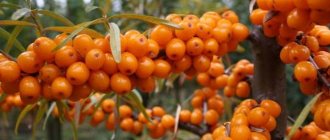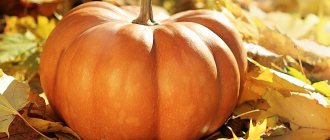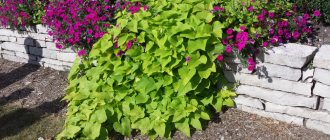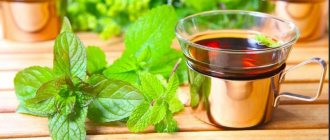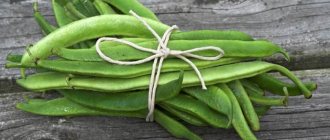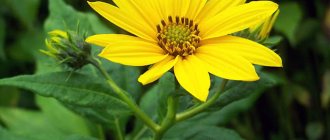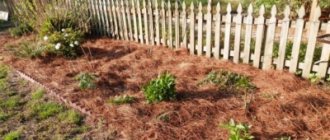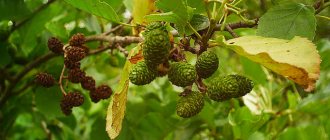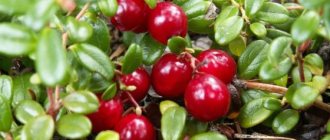↑ History of the origin of culture
The homeland of Jerusalem artichoke is North America. The local population learned to grow it and use it for food long before Europeans arrived there. In 1613, the French brought Jerusalem artichoke to Europe. It got its name from the Indian tribe - Jerusalem artichoke. Jerusalem artichoke is also called an earthen pear, since its tubers resemble the shape of pear fruits. The literal translation of the Latin name of this plant is tuberous sunflower. And this name is also sometimes used when talking about Jerusalem artichoke.
Jerusalem artichoke came to Russia in the 18th century. For a long time it was an exotic rarity. Few enthusiasts grew it, more out of curiosity or for decorative purposes.
Later, Jerusalem artichoke began to be cultivated more widely, but, unfortunately, has not yet gained the popularity it deserves due to its high yield, frost resistance, unpretentiousness and medicinal and dietary properties, for which it is superior to many vegetables.
Interesting and promising forms of Jerusalem artichoke were brought to us from the USA by the great Russian scientist Nikolai Ivanovich Vavilov, who appreciated all its amazing properties. He has repeatedly called for more active cultivation of Jerusalem artichoke.
↑ Food and medicinal properties
Ground pear is a perennial plant with remarkable properties. In terms of the yield of useful nutrients and medicinal substances, it occupies one of the first places among field crops. This is a plant that produces tasty juicy tubers underground, and on the surface there is a powerful green mass, which serves as excellent animal feed in its green form and when making silage and haylage from it.
Jerusalem artichoke tubers are a dietary food product. They can be eaten raw, they are juicy, sweetish, and taste a little like cabbage stalks; when boiled, they resemble cauliflower. You can prepare more than 20 dishes from them: salads, pancakes, cutlets, cheesecakes, soups. They are boiled, fried, stewed, dried, fermented.
Jerusalem artichoke tubers contain a large amount of carbohydrates - 58-68%. The digestible protein content is relatively low - about 2.5%, but its protein contains all the essential amino acids. Tubers are rich in vitamins and biophilic microelements. The amount of riboflavin (vitamin B2) averages 1.9 mg/kg, nicotinic acid (vitamin PP) - 18.8 mg/kg, choline - 2518 mg/kg.
The green mass of Jerusalem artichoke is also of significant value. Although the content of vitamins in it is slightly lower than in tubers, it is quite high: the content of riboflavin is 1.75 mg/kg, nicotinic acid - 8.3, choline - 950 mg/kg. In addition, 1 kg of green mass contains 60-80 mg of carotene and more than 900 mg of ascorbic acid. Green mass is richer in protein than tubers: the protein content is 9-12.5% of dry matter.
Jerusalem artichoke is superior in iron content to potatoes, carrots and sugar beets. It actively accumulates silicon from the soil, which is especially necessary for older people. Jerusalem artichoke tubers also contain 15-22% inulin, a carbohydrate that is easily converted into fructose. This is very important for patients with diabetes, since their mechanism for using the sugar that we usually eat is “disturbed.” For them, sugar is poison, and fructose is completely absorbed by the body and does not bring any harm to patients.
Research by scientists has shown that the biological activity of Jerusalem artichoke is determined not only by the presence of pure inulin, but also by the natural complex of polyfructosans and their oxidation products with a protein complex, as well as with macro- and microelement components. For therapeutic and prophylactic purposes, not only tubers are used, but also green mass.
Currently, medicines have been created and successfully used from Jerusalem artichoke to treat diseases of the cardiovascular system, diabetes, metabolic disorders, urolithiasis, gout, and atherosclerosis. They are recommended for increased physical and psycho-emotional stress, chronic fatigue, for people living in environmentally unfavorable areas, for poisoning (as a means of cleansing the body), for normalizing the functions of the gastrointestinal tract, for dry and sagging skin, and hair loss. The use of new types of dietary supplements from Jerusalem artichoke increases the effectiveness of treatment of patients with burn lesions, duodenal ulcers, as well as children with a weakened immune system.
With the systematic use of Jerusalem artichoke, along with a decrease in blood sugar levels, vision improvement is observed. If it is possible to grow this wonderful crop, then you can use “live” plants, which will turn out to be very useful.
For those who keep animals or are planning to have them, it is worth reminding that Jerusalem artichoke is an excellent forage crop. In this respect, it can be equated to corn in the phase of milky-waxy ripeness, and the tubers are equal in value to the roots of sugar beets.
The above-ground mass of the earthen pear remains green until the onset of significant frosts (up to -7 ° C); its tubers overwinter in the soil. These features distinguish it favorably from other forage crops, since it provides animals with food in late autumn and early spring, when there are no other sources of succulent food.
The special value of Jerusalem artichoke lies in its ability not to accumulate harmful substances. Jerusalem artichoke is little susceptible to diseases and pests, it is an environmentally friendly crop, and when cultivating it, you can refuse to use pesticides.
Jerusalem artichoke is attracting increasing attention as a bioenergy crop that can be processed into food, medicinal and technical products. The large amount of carbohydrates in tubers, including inulin, allows them to be used as a raw material for the production of fructose, syrups, juice, nectar, compote, marmalade, and flour for dietary baking.
Many connoisseurs and connoisseurs of beer claim that the most delicious beer is obtained when the basis for its production is an earthen pear.
Jerusalem artichoke alcohol is used as an additive to leaded gasoline.
Finally, Jerusalem artichoke is an ornamental plant, the bright yellow inflorescences of which delight our eyes in the fall, when everything around fades and fades.
Description of Jerusalem artichoke
What does Jerusalem artichoke look like: photo
This plant has a fairly powerful and strong root system. The tubers are edible. They can have different colors. There are yellow, white, red and even purple variations. In appearance, such tubers may resemble ginger root. As for taste, Jerusalem artichoke can be compared to a turnip or cabbage stalk. The Jerusalem artichoke shoot is quite strong and grows straight. The stem is covered with a small fluff. The height of the plant can vary, from forty centimeters to three meters. The upper part of the plant quite actively forms branches.
The leaves have teeth along the edges, and the surface of the plates is covered with light fluff. Jerusalem artichoke inflorescences grow about ten centimeters. They include yellow flowers that have a tubular structure. The fruits ripen at the end of summer - beginning of autumn.
Jerusalem artichoke is cultivated industrially in our country, in the USA, as well as in Asian countries. At the same time, you can find this plant in a summer resident’s garden more and more often. Not surprising, because this is an excellent help not only in terms of variety in food, but also in terms of many beneficial properties for the human body.
In terms of their chemical composition, the tubers of this crop are quite similar to potato tubers. The nutritional value is higher than that of beets.
Jerusalem artichoke is eaten raw; the tubers can also be boiled, stewed and fried. Few people know that this product can be used to make healthy teas and compotes.
↑ Morphological and biological features
The earthen pear belongs to the same genus and family as the sunflower. In appearance it is similar to a sunflower, but has a thinner and better leafy stem. The main difference is that in addition to the above-ground mass, it also forms a crop of tubers.
Plants develop a very powerful root system. When propagated by tubers, the root system is fibrous; compared to potatoes, the penetration depth is 3 times greater (up to 2 m), which allows the plant to tolerate any drought. Roots appear at the base of the buds immediately after planting the tubers and initially grow even faster than the shoots. And when the fourth and fifth pairs of leaves bloom, the roots already extend to the sides by 60-70 cm. This must be taken into account when cultivating the soil. The bulk of the roots are located in the soil layer of 0-30 cm. The roots are characterized by increased assimilation capacity.
Numerous stolons, underground shoots emerge from the underground branching part of the stem, at the ends of which tubers are formed. The length of the stolons depends on the variety and growing conditions - from 1 to 100 cm. The nodes of the stolons contain buds, thanks to which plants can reproduce by segments of stolons.
The tubers are pear-shaped, which is how the plant gets its name, and can also be fusiform, cylindrical, club-shaped, round, elongated or irregular in shape. Their number on one plant reaches several dozen. From one bush you can get up to 5 kg of tubers. The arrangement of tubers is spreading, less often compact. The tubers are smaller than those of potatoes. Their weight depends on the variety and growing conditions: 20-50 g, 100-150 and 300 g. In the northern regions they are smaller, and in the south they are not inferior in size to potato tubers. The color of the tubers is white, yellow, light brown, red, purple.
Shape of Jerusalem artichoke tubers
On the surface of each tuber, so-called eyes are formed in the form of tubercles, like those of potatoes. The apical eye-bud is much larger than the others.
Many modern varieties and hybrids of Jerusalem artichoke are close to potato tubers in shape, size and surface character of the tubers.
The tubers of the earthen pear have a thin skin with a poorly developed cork layer, so they are poorly stored and are often harvested in the spring. Tubers quickly lose moisture and dry out; at room temperature, their mass decreases by three quarters in 3-4 weeks. If the tubers are kept uncovered 7-8 days before planting, half of them will lose their ability to germinate.
The stems of the earthen pear are erect, prone to branching, cylindrical, well leafy, from 1.5 to 3 m or more in height. They are green, green-violet, reddish and dark purple in color. The thickness of the stems at the base is from 1 to 3.5 cm, at the top they are much thinner. The stems resist the wind, although thickened areas of the earthen pear sometimes lie down. The young parts of the stem are covered with long, stiff hairs, which subsequently die off.
The leaves are large (15-20 cm in length), petiolate, elongated-ovate, pointed at the end, jagged along the edge, pubescent. In the lower part of the stem the arrangement of leaves is whorled or opposite, in the middle and upper part they are alternate.
The inflorescence of Jerusalem artichoke is a basket similar to that of a sunflower, but much smaller, usually 3-4 cm in diameter. The inflorescences are located at the top of the main and lateral shoots. There are 50-60 flowers in the basket. The flowers are bright yellow, the outer ones are ligulate, the inner ones are tubular. Cross pollination. In the south, early and mid-ripening forms can be cultivated as honey plants.
The fruit is an angular achene, similar to a sunflower, but much smaller: 1-2 mm x x 3-5 mm. The weight of 1000 achenes is 7-9 g. The seeds ripen only in Central Asia and the Crimea; Seed propagation is used only in breeding.
Earthen pear (Jerusalem artichoke)
1 - leaf blade;
2 - stem with flowers; 3 - flowers: tubular (a) and ligulate (b); 4 - fruit Jerusalem artichoke is usually propagated vegetatively - by planting tubers, like potatoes. The buds begin to germinate at a soil temperature of 3-5 °C, but very slowly - seedlings appear only 30-45 days after planting. At a temperature of 8-12 °C, plants germinate in two to three weeks.
In the initial period, plants grow slowly (0.3-0.5 cm per day). At this time, the root system is formed. Maximum increases in aboveground mass occur at the end of summer: in most southern and central regions, as well as in Siberia - in July-August, and in the northern regions - in late August - early September. In 30-40 days, about 50% of the green mass is formed. In one day, height growth reaches 4-5 cm.
By the end of September, the growth of green mass stops. By this time, the plants enter the budding and flowering phase.
If in potatoes the formation of tubers coincides with budding and flowering, then in the earthen pear the tubers begin and form gradually and long before the inflorescences appear. In mid- and late-ripening varieties, in wet and cold summer the thickening of stolons coincides with the formation of 28-30 leaves on the main stem, and in warm summer - 18-24. In the southern regions, the formation of tubers begins at the end of July, in the northern regions - in August, when the growth processes of the above-ground mass are already significantly weakened. Intensive accumulation of tuber mass is observed in the second half of September and October. Tuber growth continues until frost.
The growing season for Jerusalem artichoke is long. Early-ripening forms require 120-140 days to complete a small life cycle, and mid- and late-ripening forms require 180-200 days. Therefore, in the northern regions, the flowering of plants is weak or they do not enter the flowering phase at all. Tuber formation also decreases as the crop moves north.
Jerusalem artichoke is a perennial crop. Every year, at the end of the growing season, all plant organs die off, with the exception of tubers, which, due to their high carbohydrate content, overwinter even in the Arctic Circle. In spring, one to four shoots grow from the eyes of the tuber, forming a bush. Such vegetative regeneration can last a long time, from 20 to 30 years. However, due to the thickening of plantings, their yield decreases, so thinning is necessary.
↑ Varieties
Currently, six varieties of earthen pear are included in the state register for the Russian Federation. They are recommended for cultivation in all regions of Russia.
Volzhskaya 2.
It is distinguished by its branching and tall stems, reaching 250-280 cm in hot, dry summer conditions. The dark green stems are hairy and dark red-violet. The leaves are large, their number on one plant reaches 200. The tubers are white with a purple tint, pear-shaped, often with “babies”. In the Non-Black Earth zone, 12-20 tubers are usually formed on one plant, in the sunnier south-eastern regions - up to 30-35. In nests they are located semi-spreadingly. The variety is mid-season. In the Non-Black Earth Region it forms buds, and blooms in warm years. It is characterized by increased drought resistance and immunity to diseases.
Vylgortsky.
The tubers are yellow, elongated. They are perfectly preserved in the soil in harsh winter conditions and are resistant to spring frosts.
Interest.
The tubers are white, regular in shape, smooth skin, medium-sized, deep eyes. It requires moisture, but can tolerate temporary drought. The variety is characterized by heat resistance and at the same time cold resistance.
Leningradskaya.
The tubers are white, elongated. The variety is winter hardy.
Nakhodka.
The tubers are white, pear-shaped, with pink borders around the eyes. In the soil, the tubers are arranged compactly.
Skorospelka.
The plants are short - 120-150 cm. The tubers are white, round, have a smooth surface and are very similar to potato tubers. In the soil, the tubers are arranged compactly. Plants of this variety react poorly to reduced daylight hours. Ripens 40-50 days earlier than other varieties. Winter hardiness is satisfactory.
As a result of interspecific hybridization of Jerusalem artichoke and sunflower, a new hybrid was obtained, called Jerusalem artichoke.
. In terms of purpose and use, it is largely the same as Jerusalem artichoke and has some advantages. Jerusalem artichoke tubers are more uniform in size, they are compactly located in the nest. The green mass and tubers of the hybrid have a higher content of carbohydrates, including inulin, as well as vitamins, protein and other nutrients. Some hybrids have greater cold and frost resistance and are more productive compared to Jerusalem artichoke.
↑ Growing conditions
Ground pear can grow in different soil and climatic conditions. It grows well in the south and, thanks to its exceptionally high cold hardiness and hardiness, can withstand the cold weather of the north.
In the spring, its seedlings tolerate frosts down to minus 4-5 °C, and in the fall the plants vegetate to a temperature of minus 7-8 °C. Tubers can overwinter in the soil at 40-degree frosts with a snow cover of 30 cm. Unlike potatoes, they can freeze, thaw and freeze again without losing their viability.
Jerusalem artichoke also develops well at high temperatures without being subject to heat damage like potatoes. Therefore, Jerusalem artichoke can be cultivated not only in Siberia and the northern regions, but also everywhere in the south.
Jerusalem artichoke is a short-day plant because it is of southern origin. Long days and low temperatures in the northern regions delay the formation of tubers and generative organs, but the accumulation of vegetative mass is quite intensive, so in such conditions it can be grown to produce green mass.
The earthen pear is not very demanding in terms of lighting intensity, but if it is excessively thickened due to lack of light, it significantly reduces the yield of tubers and green mass.
The plant is moisture-loving, but thanks to its powerful root system that penetrates deeply into the soil, the earthen pear relatively easily tolerates short-term summer droughts. Even in the driest years, its yield decreased much less than the yield of other crops. At the same time, the earthen pear is responsive to irrigation: its yield increases significantly with watering.
Plants react especially sharply to a lack of moisture in the soil during the tuberization and budding phases, which occur in late summer and autumn.
Jerusalem artichoke's drought resistance is combined with the ability to withstand high humidity during the growing season. At the same time, excessive moisture or close standing groundwater have a negative impact on the safety of tubers in the autumn-winter period.
Jerusalem artichoke can grow on almost all types of soil, with the exception of solonets and solonchaks. However, in acidic, swampy and heavy-textured areas, it sharply reduces the productivity of tubers and green mass. The best for it are light loamy and sandy loam soils with a neutral or slightly acidic reaction, with a deep cultivated topsoil and good moisture.
Weedy soils can also be used for this crop, as it even suppresses weeds such as wheatgrass and piggrass.
Although Jerusalem artichoke is considered an unpretentious crop, it is very responsive to improving growing conditions and, above all, nutritional conditions. Under favorable conditions, Jerusalem artichoke absorbs more nutrients from the soil than potatoes and beets. Therefore, when applying fertilizers, the yield of Jerusalem artichoke increases by 1.5-2 times.
↑ Site selection and soil preparation
When placing Jerusalem artichoke, you should remember that it grows in one place for several years. In gardens and garden plots, it is planted in the northern part. In this case, tall plants will protect the garden from northern winds. You can place Jerusalem artichoke in a strip along the street, and then it will serve as a green barrier from dust and noise. It is possible to plant Jerusalem artichoke around the perimeter of the site - this will be a green hedge. These plants can be used to “camouflage” compost heaps and other unattractive places on the site.
Jerusalem artichoke can be grown after any crops, except sunflower, which, like Jerusalem artichoke, is affected by sclerotinia, or white rot.
Soil cultivation for pears is almost the same as for potatoes.
When planting in spring, the soil is dug up in the fall to a depth of 25-30 cm, depending on the depth of the arable layer, without turning the podzolic layer to the surface. Before digging, apply phosphorus and potassium fertilizers, as well as manure (rotted manure can be applied in the spring) or other organic fertilizers. In the spring, the soil is dug up again to a depth of 20-22 cm, incorporating nitrogen fertilizers into the soil. Before planting, the area is leveled with a rake.
When planting Jerusalem artichoke in the fall, the area is dug up immediately after harvesting the previous crop.
In early spring, the soil is cultivated with a rake, then nitrogen fertilizers are applied and dug to a depth somewhat shallower than in the fall. Before planting tubers, surface tillage of the soil is carried out in order to loosen and level it. If nitrogen fertilizers were not applied for digging, they are applied for pre-sowing treatment.
↑ Fertilizer
Since Jerusalem artichoke can be cultivated in the same area for several years, high yields of tubers and green mass are impossible without organic dressing within the range of 8-12 kg/m2. The greatest effect is achieved with a combination of organic fertilizers. On average, the dose of mineral fertilizers is 20 g of superphosphate, 40 g of potassium sulfate, 20 g of ammonium nitrate per 1 m2.
The dose of applied fertilizers is adjusted depending on the fertility of the soil and the removal of nutrients from the soil by the crop. Ground pear has a high consumption of potassium: 2.4 times more than nitrogen, and 6 times more than phosphorus.
Organic fertilizers have an aftereffect even in the second year after their application. Against the background of this aftereffect, the high efficiency of mineral fertilizers is noted. In the third year, the aftereffect of organic fertilizers decreases.
On acidic soils, the effectiveness of fertilizers decreases. To eliminate acidity, the soil must be limed. Doses of lime are set depending on the degree of acidity of the soil: on heavy soils approximately 0.5 kg/m2, on light soils - 0.3-0.4 kg/m2.
↑ Landing
Ground pear is propagated, like potatoes, by tubers. But, since its tubers can overwinter in the soil without losing their ability to germinate, the earthen pear can be planted not only in spring, but also in autumn. More often, tubers are planted in the spring. In southern regions and on light soils, they can be planted before winter. On heavy soils and in areas with rainy autumns, it is more advisable to plant in the spring. It is also safer to give preference to spring planting in areas with harsh winters with little snow.
Tubers are dug out of the soil in the spring just before planting. Dug up tubers lose moisture relatively quickly, and when they dry out, their germination capacity and germination energy decrease. Therefore, for planting, it is better to use tubers that were dug up no more than three to five days ago. If planting is delayed for a longer period, the tubers should be laid in layers with soil or wet sand so that they do not dry out.
Before planting, dried tubers are soaked by immersing them in water for 4-8 hours. Their moisture content is restored.
The yield of earthen pear tubers depends on the size and quality of the planting material. The best results are obtained when planting relatively large tubers - weighing more than 50 g. The yield is slightly reduced when using medium-sized tubers - 30-50 g. It decreases even more when planting small tubers - 20-30 g. However, planting two small tubers in a nest instead one large one ensures the same yield as from large tubers.
Large tubers weighing more than 50 g can be cut in half. It is better to cut the tubers crosswise rather than lengthwise, leaving approximately the same number of eyes on each half. The cut areas can be treated with wood ash. When planting in autumn, it is better not to cut the tubers, as they are affected by fungal and bacterial diseases and produce sparse seedlings.
Before planting, the tubers are carefully inspected and sorted, removing all diseased, rotten, and moldy ones.
Autumn planting of tubers is completed before the onset of stable frosts. In the spring, planting begins as early as possible - in late April - early May, when the soil warms up to 4-6 ° C, usually 7-10 days earlier than potatoes. A 10-day delay in planting can reduce tuber yield by 12%, and planting 20 days after the optimal date can reduce tuber yield by almost one third.
The harvest of earthen pear largely depends on the feeding area. Tubers are planted in holes, grooves or immediately under a shovel, placing them at a distance of 35-40 cm from each other when planted in one row.
When growing varieties and hybrids with branched stems and spreading tubers in the nest, they are placed further apart; varieties with weakly branching stems and a compact nest shape are closer to each other.
In addition, the level of fertility and moisture availability are taken into account. In areas of high fertility with a good supply of moisture, the distance between plants can be reduced to 30 cm, and on fertile soils with a lack of moisture, on the contrary, increased to 60 cm.
The depth of planting tubers should not exceed 6-8 cm on soils of medium mechanical composition, and on light soils - 8-10 cm. Deeper planting of tubers leads to a decrease in yield. Only during autumn planting are the tubers buried 2-3 cm deeper to eliminate sudden temperature fluctuations in the nest.
↑ Caring for plantings in the first year of life
Shoots of the earthen pear appear in about three weeks. During this time, weeds sprout, and after rains a crust may form. Therefore, even before the emergence of seedlings, you need to harrow the area with a rake. If harrowing is carried out every 5-7 days, then you can do without manual weeding. Harrowing can also be carried out on seedlings while the plants are still small. When the plant height is 10-15 cm, the row spacing is loosened, and when the plants reach a height of 30-40 cm, they are hilled up. Hilling strengthens plants, promotes the formation of roots and tubers, improves aeration and soil temperature.
If the plants develop poorly, nitrogen fertilizing is carried out. In dry summers, Jerusalem artichoke plantings are watered.
When the rows are closed, the earthen pear itself drowns out the emerging weeds, so treatment of the row spacing is not required.
↑ Caring for plantings in the second and subsequent years of life
In the second year of life, nitrogen-phosphorus-potassium fertilizers are applied in the spring before tubers are harvested. In the third year and every 2-3 years thereafter, well-rotted manure is applied superficially. When digging up tubers, the applied fertilizers are incorporated into the soil.
Shoots appear in the second year a little earlier than in the first year, but less quickly, since the tubers are located in the soil at different depths. When the plant height is 15-20 cm, furrows are formed by cutting out all the plants between the furrows. Then the entire summer agrotechnical cycle is repeated.
In the second and subsequent years, plant thickening should not be allowed, consistently removing periodically appearing shoots.
Edible beauty ↑
Jerusalem artichoke has earned the love of flower growers as well. Its mass plantings form magnificent hedges. Planted along the perimeter of the site, it becomes a reliable shield from the wind and rodents. Also, it easily displaces weeds and weeds from the site.
At the same time, the yellow caps of inflorescences on tall stems look good in the background.
Yellow flowers can become a bright background for a country-style flower garden or a garden decorated in one color scheme.
But that seems to be all, in short. I hope you liked the plant, and there is a secluded place in the garden for Jerusalem artichoke. Moreover, this is a great opportunity to combine business with pleasure. Or maybe you know how to use the properties of Jerusalem artichoke in dishes. Send recipes with photos.
↑ Harvesting and storage of crops
The aboveground mass of the earthen pear is harvested before the onset of autumn frosts. In the conditions of the central regions of the Non-Black Earth Zone, the harvesting period falls on September 15-20. By this time, the accumulation of nutrients in the stems stops; the tubers continue to grow until winter arrives.
The green mass is cut at a height of 20-30 cm. The nutrients from the remaining part of the stem enter the tubers, significantly increasing the yield. For this reason, the tuber yield is higher in spring than in autumn.
If the above-ground mass is not cut off and left for the winter, the yield of tubers and their quality will be higher.
Earthen pear tubers can be harvested in autumn and spring, but it is better in spring, since they overwinter well in the soil, and it is difficult to store them dug up.
In autumn, tubers are dug up before the onset of stable cold weather before the soil begins to freeze; in the spring - at the first opportunity, before the eyes of the tubers begin to grow.
The earthen pear is harvested in the same way as potatoes.
↑ Storage of tubers
Since the tubers of the earthen pear have an underdeveloped cork layer and dry out quickly in the open air, they are often harvested in the spring. However, if necessary, they can be stored for a long time. Store the tubers in the cellar at a temperature of 0-2 °C, sprinkling them with sand in layers every 10 cm.
You can place tubers for storage in piles and trenches. Approximate size of the collar: width 1-1.5 m, height 1-1.2 m, length arbitrary. The tubers are laid in layers: a layer of tubers, a layer of sand or soil. The layer thickness is 10 cm. The top of the pile is covered with a layer of soil about 20 cm thick. The pile is dug in with a ditch to drain water.
The trenches are made 0.5 m deep and 1-1.5 m wide. The tubers are laid in layers with sand or soil, as in a pile.
Small quantities of tubers are stored in freezers and refrigerators.
↑ Release of areas from Jerusalem artichoke
After the expiration date of the crops, the tubers are carefully removed, and to eliminate the shoots, you need to mow the Jerusalem artichoke when the nutrients from the tubers are completely consumed and new tubers have not formed. For the Moscow region, calendar dates have been established for mowing Jerusalem artichoke - two or three five-day periods between July 10 and July 25.
An earthen pear, mowed and dug up before July 10, grows from the ungrown mother tuber and from the rooting remains of the mowed stems. When mowing after July 25, no shoots appear in the first year, but the next year, due to the young tubers preserved in the soil, the earthen pear is restored.
How to choose and where to store?
How to choose? You should buy Jerusalem artichokes in season - from October to March. Choose firm, fresh root vegetables with pale brown skin, making sure there are no dark spots. It is better to discard soft and wrinkled fruits.
How to store? The best temperature for storing Jerusalem artichoke is from +1 to +4°C, humidity - no more than 85%. A cellar or refrigerator is suitable for storage. Storage in the freezer is allowed. To store in the refrigerator, Jerusalem artichokes are placed in a container or bag with a clip-on closure. In this way, fresh Jerusalem artichoke can be stored for up to three to four weeks. In the freezer - up to three months.
[Video] How to store Jerusalem artichoke at home:
↑ Diseases
The most dangerous disease of earthen pear is white rot, or sclerotinia. It affects both the above-ground part and the tubers. Initially, brown spots appear on the lower part of the stem, which gradually cover the entire stem, and then the inflorescence. The above-ground part dries out, and the roots and tubers rot.
The source of infection is diseased tubers, stems, leaves, and soil on which diseased plants grew.
The earthen pear cannot be planted on lands that were occupied by sunflowers, carrots, turnips, beets, infected with white rot, or returned to the old place before 4-5 years. Only healthy tubers should be selected for planting.
On acidic soils, sclerotinia develops especially strongly. Therefore, liming not only increases productivity, but is also a measure to combat white rot.
The benefits of Jerusalem artichoke for the human body
The beneficial properties of Jerusalem artichoke for health are justified by the content of a record number of active substances, where the greatest benefit was noted for inulin, an organic substance of the polysaccharide group. The root of the plant contains 6 daily norms of inulin.
The percentage of prebiotic in a vegetable tuber often exceeds 20%, which equates the plant to a natural remedy in the fight against diabetes. The benefits of Jerusalem artichoke include the following properties:
- cleansing the body of toxins and toxic substances;
- improving the functioning and treatment of pathologies of the digestive tract, mainly the intestines;
- prevention of cardiovascular diseases;
- normalization of psycho-emotional state;
- strengthening the immune system;
- beneficial effects on the skin.
↑ Use of Jerusalem artichoke in folk medicine and cosmetology
Thoroughly washed Jerusalem artichoke tubers are taken fresh before meals, 50 g three times a day for 30 days. The squeezed juice from washed tubers is taken immediately after preparation, 50 ml three times a day for 30 days.
Freshly grated, washed tubers (25-30 g) are applied in a thin layer to the face and kept for 30 minutes. The procedure is carried out two to three times a week. This helps get rid of wrinkles, the face becomes clean and soft.
For long-term use and storage, the tubers are washed well and cut into slices 3-4 mm thick and dried in the shade, like apples for compote. The cut slices can be dried in the oven at 70°C. Jerusalem artichoke crackers are stored in a cotton bag; they have a sweetish taste. They are soaked in boiled water and used like fresh tubers. The water after soaking the slices can be drunk as a tincture of the leaves.
Dried tubers can be used to prepare compote: pour 3 tablespoons into 1 liter of water, boil and drink without adding sugar. They can be eaten with milk, tea, coffee.
You can dry Jerusalem artichoke tubers in another way: boil the washed tubers with boiling water so that the outer peel softens and the pulp inside remains dense. Grind the peeled tubers on a grater and spread them in a thin layer on a sieve and dry. The result is a product similar to cereal. Take 1 tablespoon of Jerusalem artichoke dried in this way, brew 2 cups of boiling water, cool, strain through cheesecloth and drink 1 cup twice a day 15-20 minutes before meals for 20 days.
The crushed leafy mass of the upper tiers of shoots is poured with boiling water - 2 tablespoons per 0.5 liters of water. You can use raw and dried mass. Leave for 6-8 hours, then strain and drink 0.5 cups four times a day 15-20 minutes before meals for 20 days.
Jerusalem artichoke leaves, collected in July-September from the upper tiers of green shoots, are dried in the shade and used to make tea: 2 teaspoons of dry leaves are poured into a glass of boiling water and left for 20 minutes.
Green or dry leafy mass of Jerusalem artichoke is used for bathing. 1-1.5 kg of dry mass is poured with boiling water in an enamel bucket, left for 4-6 hours, filtered and added to the finished bath. Take 15-20 minutes twice a week. Course - 10 baths.
Planting and caring for Jerusalem artichoke
- Planting: planting tubers in the ground before winter, 2-3 weeks before frost.
- Lighting: bright sunlight.
- Soil: any neutral or slightly alkaline (6.0-7.5 pH), except for saline soils and very heavy soils.
- Watering: only during periods of prolonged drought. Water consumption is 10-15 liters for each plant.
- Feeding: mineral fertilizers - annually in the spring, organic fertilizers - once every 2-3 years in the fall.
- Reproduction: usually by tubers or their parts with eyes, much less often the seed method is used.
- Pests: slugs, mole crickets, wireworms.
- Diseases: white rot, alternaria or powdery mildew.
Read more about growing Jerusalem artichoke below.
